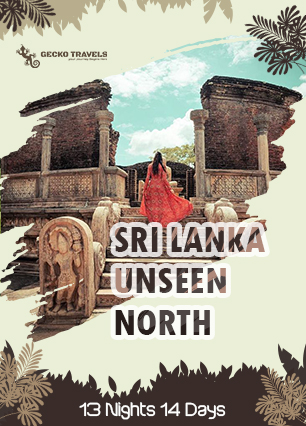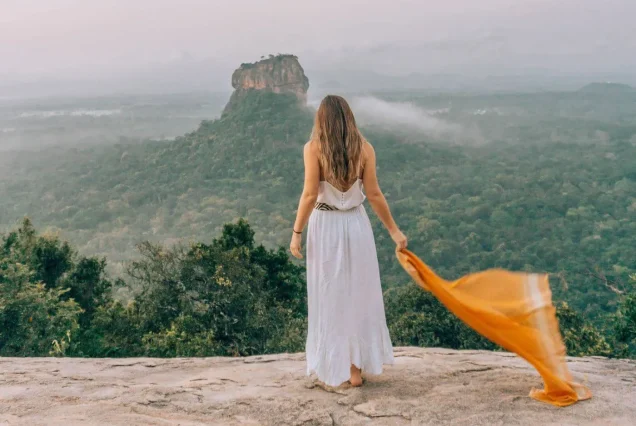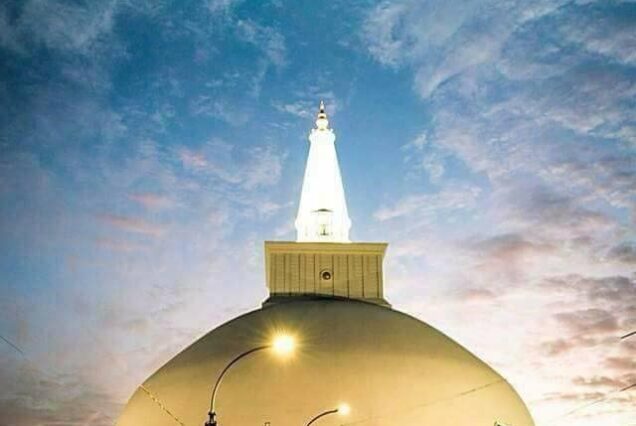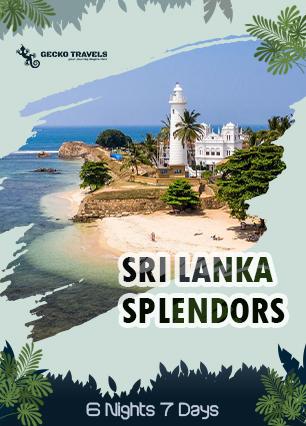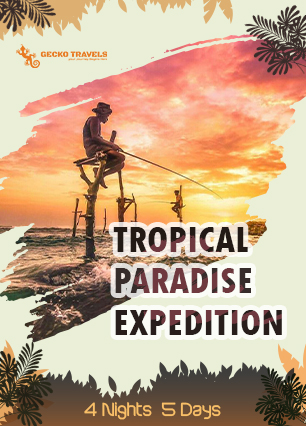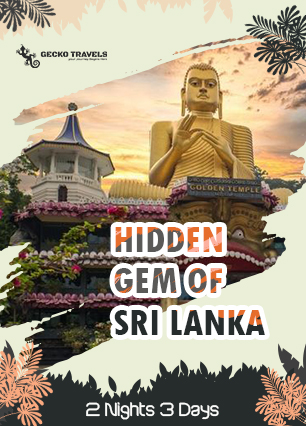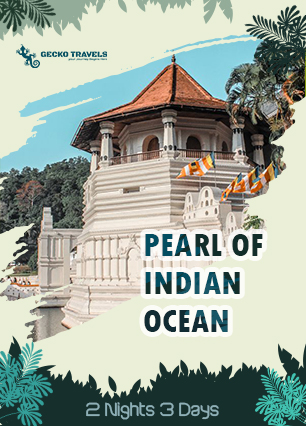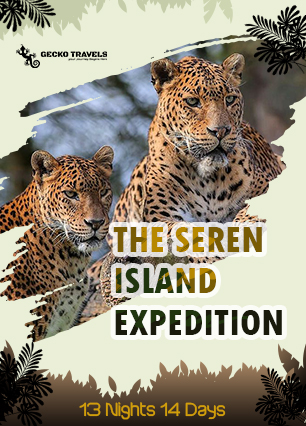SRI LANKA UNSEEN NORTH – 13NIGHTS 14 DAYS
Overview
The Sri Lanka Round Tour and Beach Stay Program seamlessly blend cultural exploration and beachfront bliss, offering you the best of both worlds. Immerse yourself in the rich Culture, Heritage and Nature wonders of Sri Lanka, followed by a well-deserved beach retreat that will leave you rejuvenated and filled with unforgettable memories.
HIGHLIGHTS OF THE TOUR
* Pidurangala
* Anuradhapura Ancient City
* Safari at Wilpattu National Park
* Murikandy Pillayar Shrine
* Hasalaka Gamini War Hero Monument
* Naga Vihara Temple
* Delft Islands
* Jaffna City Tour
* Nallur Kandaswamy Kovil
* Point Pedro
* Light House
* Bottomless well
* Naguleswaram Kovil
* Keerimalai Sacred Water Spring
* Dambakola Patuna – Sri Sangamitta Viharaya
* Casurina Beach
* Jaffna Fort
* Nagadeepa Island – Nagadeepa Viharaya
* Nagapooshani Amman Kovil
* Koneswaram Temple
* Girihanduseya (The first Stupa in Sri lanka)
* Pigeon Island
Included/Excluded
- Meet, assist and welcome on arrival at Colombo airport.
- Accommodation at above hotels or similar mentioned in the itinerary sharing Double/twin including with breakfast & dinner
- Transportation in a A/C Vehicle with the service of Language speaking guide or Chauffeur for the round tour
- 2 bottle of 500 ml will be given per day per person)
- Airport pick up & Airport drop off
- Fuel & local insurance for the vehicle
- Fuel & local insurance for the vehicle
- All government taxes
- Entrance tickets at the sites
- Breakfast on the arrival day
- Lunch & Beverages at all hotels.
- Late check-outs or early check-ins
- Items of a personal nature such as laundry, telephone calls, tipping to service.
- Other services that are not mentioned in the program.
- Visas
- Any Airfares / travel Insurance / Airport taxes
- All expenses of personal nature
- Tips and portage & Gratuities.
- Any camera fees
Tour Plan
Our representative will pick you from Colombo International Airport and you will be transferred to Negombo
Check-in at hotel and relax (Check-in at 02.00 pm. Early check-in can confirm on availability. If not client have to pay for the early check-in)
Dinner & overnight stay at Negombo
After breakfast check-out and transfer to Sigiriya (Drive time approx. 4 hrs)
Upon arrival visit Pidurangala Rock
Pidurangala is an enormous rock located a few kilometres north of Sigiriya. The two rocks have an interlinked history: whilst King Kasyapa was building Sigiriya Rock Fortress in the 5th century, he moved monks living around Sigiriya to a new monastery on Pidurangala Rock. An ancient cave temple still houses objects from various vintages that reflect Buddhist, Hindu and western beliefs, and the stupa to the left of the temple entrance is believed to mark the spot where King Kasyapa was cremated. Pidurangala is a more challenging climb than Sigiriya, so should not be attempted by those with poor physical fitness. There is no clear path to the top: steep, uneven steps give way to an expanse of boulders and crevices that climbers must navigate in order to reach the summit. From the top, there are glorious vistas of the surrounding landscape and an incredible view of the majestic Sigiriya Rock.
There after transfer to Habarana and check-in at hotel
Dinner & overnight stay at Dambulla
After breakfast check-out and transfer to Anuradhapura (Drive time approx. 2 hrs)
Upon arrival proceed on a sightseeing tour in Anuradhapura Ancient city
ANURADHAPURA is Sri Lanka’s first capital, a potent symbol of Sinhalese power, and the most extensive and important of island’s ancient cities. It became a capital in 380 BC and for over 1000 years Sinhalese kings ruled from this great city. The Sacred Bo-Tree(Sri Maha Bodi) is the city’s holiest site, and was grown from the tree under which Buddha achieved enlightenment. The Thuparama Dagaba, the oldest of the many temples in Anuradhapura, is believed to contain the right collar-bone of Buddha.
WILPATTU NATIONAL PARK
(Safari time 14.30 hrs to 17.30 hrs – 3 hrs)
Situated 176 km. north of Colombo, Willpattu is approximately 1,908 sq.km. in extent. It has a dense jungle cover which makes it a more exciting park where animals have to be tracked. There are numerous delightful little lakes – known as villus – and the leopard and sloth bear are the specialty rather than elephants.
Check-in at hotel in Anuradhapura and relax
Dinner & overnight stay at Anuradhapura
After breakfast check-out and transfer to Iranamadu (Drive time approx. 2 hrs 30 mins)
Upon arrival visit Murikandy Pillayar Shrine
Murikandy Pillayar Shrine is a Hindu temple which is situated in Murikandy village in the Jaffna peninsula. The temple is dedicated to Lord Ganesh and is a frequently visited temple by people who travel along the Kandy – Jaffna Highway. It is believed that a visit to this temple would remove all obstacles during travel. The temple is visited by both Hindus and Buddhists whilst being a symbol of harmony between both religions.
On completion transfer to Kilinochchi and visit the War Memorial Monument
(Drive time approx. 20 mins)
Kilinochchi War Memorial is located in Kilinochchi. To visit Kilinochchi War Memorial on your holiday in Kilinochchi, and find out what else Kilinochchi has to offer, use our Kilinochchi.
Transfer to Elephant Pass and visit Hasalaka Gamini War Hero Monument (Drive time approx. 30 mins)
A statue of War Hero Corporal Gamini Kularatne of the Sri Lanka Army (also known as ‘Hasalaka Gamini’ or ‘Hero of Hasalaka’) who sacrificed his own life to rescue hundreds of fellow soldiers who were outnumbered in large and were under siege by LTTE fighters at the Elephant Pass Sri Lanka Army garrison in 1991 can be seen at Elephant Pass on the A9 road on the way to Jaffna. The statue has been erected at the place where the War Hero sacrificed his life and the LTTE’s battle tank he blew up in the action also still stands and displayed where it stopped on that day. As one of the most ferocious battles in Sri Lanka’s modern history ended with that action, the Army camp which was under siege for nearly a month was saved in most part by Corporal Kularatne’s bravery and sacrifice.
There after transfer to Jaffna and visit Naga Vihara Temple (Drive time approx. 1 hr 30 mins)
Today the naga vihara temple in Jaffna, Sri Lanka is a popular rendezvous spot of tourists and devotees. Jaffna is a great destination to enjoy and entertain your holidays. The spot is considered whereas the sapling of Jaya Sri maha Bodhi was arrived to sri lanka by Theri Sangamitta and Thero mahinda. So that King Devanampiya tissa came to the destination and welcomed prestigiously.
Check-in at hotel (Drive time approx. 5 mins – 700m)
Dinner & overnight stay at Jaffna
After breakfast visit Delft Islands
DELFT ISLAND
Neduntheevu or Neduntivu (also known by its Dutch name Delft) is an island in the Palk Strait, northern Sri Lanka. This island is named as Delft in the Admiralty Chart unlike the other islands, whose names are Tamil. The island’s area is 50 km² and it is roughly oval-shaped. Its length is 8 km and its maximum width about 6 km.
Neduntivu is a flat island surrounded by shallow waters and beaches of coral chunks and sand. It is home to a small population of Tamil people, mostly living in quiet compounds close to the northern coast. The vegetation is of a semi-arid tropical type, with palmyra palms, dry shrubs and grasses that grow on the pale Grey porous coralline soil. Papayas and bananas grow close to the local people’s homes. In the western coast of the island there are remains of a 1000-year-old temple built by the Chola Dynasty,[as well as the ruins of a Dutch colonial fort. The water is slightly brackish, and it is taken from shallow wells using buckets made from palmyra palm leaves. A naval battle was fought off the coast of the island in 2008 during the Sri-Lankan Civil War. There are feral ponies on the island, descendants of forebears abandoned there in the Dutch period.
Return to hotel and relax
Dinner & overnight stay at Jaffna
After breakfast proceed on a city tour in Jaffna City including Nallur Kandaswamy Kovil
JAFFNA is the capital city of the Northern Province of Sri Lanka. It is the administrative headquarters of the Jaffna District located on a peninsula of the same name. With a population of 88,138 in 2012, Jaffna is Sri Lanka’s 12th most populous city. Jaffna is approximately six miles (9.7 kilometres) from Kandarodai which served as an emporium in the Jaffna peninsula from classical antiquity. Jaffna’s suburb Nallur, served as the capital of the four-century-long medieval Jaffna Kingdom.
Thereafter Proceed to Point Pedro. En-route visiting the Bottomless well at Nilavarai
Nilavarai well is a deep underground natural water well thought to be bottomless.
It is an archeological monument in Jaffna Peninsula and has many enthralling legends adding to the mysteries that encircle it. Almost all legends are connected with the Ramayan, the chronicles of Rama – the seventh avatar of God Vishnu.
According to legend, Seetha, wife of Rama, while on the return journey to India was overcome with thirst and as there was no water to be found, Rama had gallantly shot an arrow on to the earth creating a well and it was the origin of Nilavarai. Varying legends replace different characters such as Hanuman, a devotee of Rama, shooting an arrow to create the well in a bid to quench Rama’s thirst and so on. Regardless, since the olden times the well has been a source of fresh water that never seemed to deplete and is also used for irrigation activities in the area.
In contrary to the beliefs of the wellbeing bottomless, a recent expedition carried out by the divers of Sri Lanka Navy with the help of an automated robot managed to find the bottom of this mysterious well at a depth of 52.5 meters (172 feet). It was further discovered that several tunnels located at different levels inside lead towards different directions. At least one of the tunnels is believed to be connected to the Keerimalai pond.
In Point Pedro, visit the Light House and its beach including the Northernmost point of Sri Lanka.
Point Pedro is a town, located in Jaffna District, Sri Lanka, at the northernmost point of the island. Cotton is produced around Point Pedro in the fertile calcic red latosol soils. The eastern coast of Point Pedro forms a 3 mile wide, 20 mile long beach with sand dunes up to 100 feet high, extending to Thalayady. The porous soil has a water table deep underground with an estimated one billion litres of fresh water. The Boxing Day tsunami of 2004 raised the salt content of the ground water. The tsunami destroyed parts of the town and submerged some parts with seawater up to 4 feet deep.
Proceed to Keerimalai and visit the Naguleswaram Kovil and the Sacred Water Spring at Keerimalai
Keerimalai is situated about 4 km west of Kankasanthurai and is about 50 feet above the sea level. The Keerimalai natural springs is famous for its water and rituals. The water comes from an underground fresh water spring and Hindus believe that the water here has miraculous powers to cure diseases. One wonder of Keerimalai is its water being absolutely fresh despite it being just next to the ocean. The legends associate the place with an Indian sage named Nagula Muni. He was called by that name because he had a mongoose-like face due to a curse. (‘Nagula’ in Sanskrit means mongoose, and ‘keeri’ is the Tamil synonym for the word). After taking bath in these natural springs he was relieved of his curse and acquired a human face. He made the place as his abode thereafter, and hence it became Keerimalai. The Siva temple established by this sage at this place was named Nagulesvaram and according to the chronicles of Jaffna, it is one of earliest Hindu Temples of Sri Lanka. The legends continue to say that later a Chola princess named Maruthapura Veeravalli built the nearby Maviddapuram Kandaswamy Temple after she was relieved of a curse of having a horse-like face by taking bath in these springs. Hindus flock in large numbers on ‘Aadi Amaavaasai’ day which falls during the Tamil month of ‘Aadi’, to carry out rituals for their forefathers and take a divine dip in the natural springs. Keerimalai is famous for Aadi Amaavaasai and continues to be the foremost place for it. At this site you could see an antient hall for the devotees to carry out these rituals. The water from these springs is not warm as in thermal springs. The depth of the tank is about 4 feet, and visitors can take a dip in it or swim for a charge of Rs 30 per person. There are separate bathing sections for males and females and the female’s section is enclosed.
On completion proceed to Dambakola Patuna to visit the Sri Sangamitta Viharaya
Dambakola Patuna (Historically known as ‘Jambukola Patna’) has been an ancient port in the North of Jaffna peninsula which was used during pre-Christian times. After Arahath Mahinda introduced Buddhism to Sri Lanka in 250 B.C, his sister, Sanghamitta Theri arrived in Sri Lanka with a sacred Bo sapling one year later to this port. The temple Jambukola Viharaya was built commemorating the arrival of the Bo sapling by King Devanampiya Tissa (250 – 210 B.C) and one of the first eight shoots of the Sri Maha Bodhi was planted by the King at the same place where he kept the original tree before bringing it to the capital Anuradhapura. King Vijayabahu I (1070 – 1110 A.D) has restored this site. The remains of the Vihara such as the Buddha footprint stone and the Vatadage which were seen up to recent times no longer exist. This port gradually faded in importance while port Mahathiththa (Also known as Mahathota, Manthota and now Manthai) located at the mouth of Malvathu Oya developed as a key intersection of sea routes and the Dambakola Patuna was lost in time. The great chronicle of Sri Lanka, the Mahavamsa and the Samanthapasasdika mention pilgrims coming from various countries to Jambukola to worship the Viharaya in the ancient times. However today there is nothing at the temple which shows any antiquity. All the structures in the temple including the stupa were rebuilt and the present Bo tree was planted by the Sri Lanka Navy in 1998 after the liberation of the land from LTTE rule.
Thereafter proceed to the Casurina Beach of Karainagar
The Casuarina Beach in Karainagar is considered the best beach frontage in the Jaffna Peninsula. The beach lies on the North of Karativu island, one of the largest islands in the peninsula which is connected to the mainland over a causeway. The beach probably has got its name due the Casuarina (Kasa) Trees along this beach. It lies about 22 km off Jaffna town and may take about 45 minutes to travel by a vehicle. The sea at Casuarina Beach is so shallow that you can walk a long way in to the sea in the deep blue water with gentle waves moving towards the land. Except for the very high spring tides, the beach is a wide expanse of white sand, a great place to walk, go for a run or just enjoy the evening breeze and setting sun. The main activity in the area is fishing. The fisherman in the area use type of a flat boat made out of wooden logs which resembles a full boat cut in half. These are used to fish in shallow waters and move about prawn farms in the sea. Having a bath or wading water at the Casuarina Beach would definitely be a part of the itinerary for visitors to Jaffna Peninsula.
Return to hotel and relax
Dinner & overnight stay at Jaffna
After breakfast check-out and visit Jaffna Fort (Drive time approx. 10 mins)
Jaffna Fort is situated on the south side of the Jaffna peninsula at the water’s edge of the lagoon, the ancient Jaffna Fort is the second largest existing fort in the Island. Originally built by the Portuguese in 1619 and re-built and expanded by the Dutch during the second half of the 17th and the 18th centuries to facilitate trading activities of Sri Lanka’s northern region, indicate not only of Jaffna’s strategic importance to Europeans but its significance throughout Sri Lanka’s history.
Thereafter proceed to Kurikattuwan Jetty to take a ferry to Nagadeepa Island
Upon arrival visit the Nagadeepa Viharaya
Nagadeepa Temple (Nagadeepa Purana Viharaya) is an ancient Buddhist temple situated on the Nagadeepa Island (Nainativu) off the coast of Jaffna Peninsula. It is one of Sri Lanka’s 16 holiest Buddhist shrines known as ‘Solosmasthana’. The name of the island alludes to the folklore inhabitants, the Naga tribal people. Nāka Tivu or Nāka Nadu was the name of the whole Jaffna peninsula in some historical documents. The Greek cartographer Ptolemy described the territory including islands around the Jaffna peninsula as ‘Nagadibois’ in the first century CE. In the historical legends of Sri Lanka such as Mahawansa and in the ancient Indian Tamil Sangam literature Manimekalai the island was mentioned as ‘Manipallavam’ of Nāka Tivu. Nagadeepa Temple is known as the place where Lord Buddha visited during his second visit to Sri Lanka to mediate and settle a dispute between two Naga tribal kings, Chulodara and Mahodara over the possession of a gem-studded throne. The legends state that after having listened to Buddha’s Dhamma sermons the two warring kings made peace and they offered the throne in unison to Lord Buddha, who returned it to the Naga kings. The Rajayathana stupa was constructed by the two Naga kings at the site where Lord Buddha preached Dhamma and the gem studded throne was enshrined in the stupa and it became a place of Buddhist veneration. The ancient Indian Tamil epic Manimekala mentions a gem studded throne and a stone with the Buddha’s footprints at Nagadeepa which pilgrims from India used to come and worship. The subsequent history records that the Nagadeepa Viharaya was developed by pious kings Devanampiyatissa and Dutugemunu. During the Portuguese colonial period the Temple was destroyed and the devotees were deprived of the site. Later in 1930s the Buddhists led by Randombe Somatissa Nayaka Thero restored the temple. Objects of archeological and religious interest are still found at the site such as the stone sculptured Buddha statue that was unearthed recently during an excavation.
Thereafter visit the Nagapooshani Amman Kovil
Return to Jaffna and transfer to Trincomalee (Drive time approx. 4 hrs 30 mins)
Check-in at hotel and relax
Dinner & overnight stay at Trincomalee
After breakfast morning relax by the beach
Afternoon proceed on a city tour in Trincomalee City including Koneswaram Temple
TRINCOMALEE (Excursion time 1 hr 30 mins)
Trincomalee also known as Gokanna/Gokarna, is the administrative headquarters of the Trincomalee District and major resort port city of Eastern Province, Sri Lanka. Located on the east coast of the island overlooking the Trincomalee Harbour, 237 kilometres (147 mi) north-east of Colombo, 182 kilometres (113 mi) south-east of Jaffna and 111 kilometres (69 mi) miles north of Batticaloa, Trincomalee has been one of the main centres of Sri Lankan Tamil language speaking culture on the island for over two millennia. With a population of 99,135, Trincomalee city is built on a peninsula of the same name, which divides its inner and outer harbours. People from Trincomalee are known as Trincomalians and the local authority is Trincomalee Urban Council. Trincomalee city is home to the famous Koneswaram temple from where it developed and earned its historic Tamil name Thirukonamalai. The town is home to other historical monuments such as the Bhadrakali Amman Temple, Trincomalee, the Trincomalee Hindu Cultural Hall and, opened in 1897, the Trincomalee Hindu College. Trincomalee is also the site of the Trincomalee railway station and an ancient ferry service to Jaffna and the south side of the harbour at Muttur.
Return to hotel and relax
Dinner & overnight stay at Trincomalee
After breakfast visit Girihanduseya (The first Stupa in Sri lanka)
Girihandu Seya (also known as Nithupathpana Vihara is an ancient Buddhist temple situated in Thiriyai, Trincomalee, Sri Lanka. The temple is supposed to be the first Buddhist Stupa in Sri Lanka, believed to be constructed by two seafaring merchants Trapusa and Bahalika. The names of the two merchants are recorded in a rock inscription found in the Vihara premises. According to the inscription, Girihandu Seya was built by the guilds of merchants named Trapassuka and Vallika where the names are written as Tapassu and Bhalluka in later Sinhala chronicles. Some scholars also hold the view that Mahayana influenced seafaring merchants from the Pallava Kingdom were responsible for the construction of this temple.
There after return back to Trincomalee and enjoy a boatride to Pigeon Island to have a swim (Snorkeling can be arranged for an extra cost at the site)
Pigeon Island National Park is one of the two marine national parks of Sri Lanka. The national park is situated 1 km off the coast of Nilaveli, a coastal town in Eastern Province, encompassing a total area of 471.429 hectares. The island’s name derives from the rock pigeon which has colonized it. The national park contains some of the best remaining coral reefs of Sri Lanka.[1]Pigeon Island was designated as a sanctuary in 1963. In 2003 it was redesignated as a national park. This national park is the 17th in Sri Lanka. The island was used as a shooting range during the colonial era.[2] Pigeon Island is one of the several protected areas affected by the Indian Ocean tsunami in 2004
Return to hotel and relax
Dinner & overnight stay at Trincomalee
After breakfast full day relax by the beach
Dinner & overnight stay at Trincomalee
After breakfast check-out and transfer to the Airport for departure transfers. Have a safe flight!!
(Drive time approx. 6 hrs)
— END TOUR —

